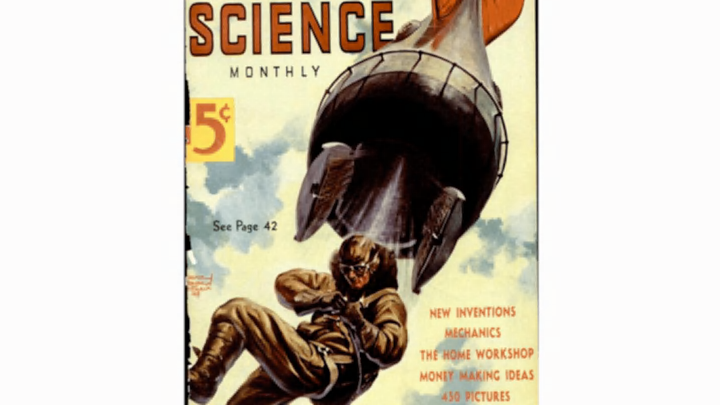Since 1872, Popular Science has been on the cutting edge. From the fanciful to the dead-on, here are some of their most enjoyable covers.
1. September 1917

Even PopSci was skeptical of this decked out star bicycle, writing, “The air propelled unicycle is much too complicated to operate successfully.”
2. November 1917

To fight enemy subs, the government considered building these floating fortresses. Not for the easily queasy, four soldiers could live inside the giant buoys, which had living quarters 20 feet below. (It was even supposed to come with a telephone!)
3. March 1921

Built in 1888, this nine-mile monorail linked the villages of Listowel and Ballybunion in County Kerry, Ireland. But three years after appearing on PopSci’s cover, the train’s track-straddling days were over. The rail was scrapped. In 2003, a 1000-yard stretch of track was restored, which you can now ride.
4. April 1923

Inventor E. J. Christie believed his 14-foot-high gyroscopic unicycle would shatter the world’s speed records. It was supposed to go 115 mph.
5. October 1930

George Bennie built a prototype of his overhead railplane in Milngavie, Scotland. Although PopSci predicted it could whiz along at 150mph, the idea was left hanging. Bennie went bankrupt in 1937, and his creation was destroyed two decades after.
6. April 1932

With motors mounted at the center of each tire, a working model of a steam-wheeled vehicle actually took off in a Chicago lab.
7. March 1933

With fins supplying lift, Victor Strode’s winged speedboat was predicted to skim atop the waves at 70 mph. He even landed a patent for the design.
8. April 1933

Volcanologist Arpad Kirner wore this asbestos and steel suit when he descended 800 feet into Mt. Stromboli’s inferno. He lived to write about the tale in this issue.
9. November 1933

Clearly, PopSci's editors had a thing for unicycles. But this one-wheeler was not for clowning around—it was a battle weapon. The motorized unicycle could be converted into a one-wheeled tank, reaching speeds of 100 mph. As for economy? It was supposed to get 280mpg.
10. July 1936

Dubbed a “tumbleweed tank,” this bowling ball of doom was designed to deflect bullets. A fixed, hollow sphere protected troops inside while a rotating outer shell rolled them toward the enemy.
11. August 1936

“Churning the air with wing-shaped paddles mounted on giant, wire-spoked wheels, an odd plane recently devised resembles a pair of flying Ferris wheels,” PopSci wrote.
12. August 1938

Decades before protective suits made high altitude skydives possible, J. J. Dunkel wanted to visit the stratosphere. According to this issue, the daredevil planned to ride inside a bomb-shaped gondola, which would float via balloon to 110,000 feet. The balloon would release, leaving the capsule—and Dunkel inside—freefalling. At 30,000 feet, a parachute would slow the gondola’s descent and, at 5000 feet, a trap door would open, allowing Dunkel to parachute down on his own. The plan never got off the ground.
13. June 1939

Now this is water polo. “In a thrilling new aquatic sport, players are mounted on dummy horses that skim over the water under the power of outboard motors,” wrote PopSci.
14. March 1940

Picture this battle scene: “Solders hurling themselves across wide streams at a single leap, charging over battlefields at high speeds, flying across wide trenches and gaping shell holes in a series of broad jumps…” That’s what inventor George de Bothezat envisioned. His one-man helicopter was supposed to be handy for sportsmen, too.
15. January 1956

One year before the U.S. launched its first satellites into orbit, PopSci took a stab at what they’d look like. Although the Americans eventually favored a different design, the rendering does resemble Russia’s Sputnik.
16. July 1959

Powered by propeller, William Bertelson’s aeromobile rode atop a smooth bubble of air. Although it was one of the first successful hovercrafts, it had a few bugs.
17. May 1966

Buckminster Fuller was the poster boy for geodesic domes. His designs inspired Spaceship Earth at Epcot and the Montreal Biosphere. Less popular, though, were his plastic pool domes, which kept your personal swimming hole warm almost year round.
18. July 1966

“If development work now under way is successful, as appears likely, it will soon be possible for you to own a revolutionary low-cost glass-bubble submarine that can drive to the ocean floor. It will cost about the same as a small cabin cruiser.”
19. November 1971

In the 1970s, the government was serious about podcars. The U.S. Department of Transportation liked the idea so much that Secretary John Volpe announced a $6 million plan to install four systems. Although some are scattered about the world, the idea didn’t catch on. A nine-mile stretch still winds through WVU Morgantown, transporting about 15,000 people a day.
20. July 1973

Motorola’s DynaTAC phone—the original brick—weighed 2 pounds and sold for $3995. Inventor Martin Cooper made the first handheld call with it while walking around New York City. “I made numerous calls, including one where I crossed the street while talking to a New York radio reporter—probably one of the more dangerous things I have ever done in my life,” Cooper said.
21. January 1981

Those extra blades on a wind turbine? Wasted space! That’s what Dr. Rudolph Meggle believed, who sketched this colossal windmill—a 394-foot, one-armed behemoth with a 35-ton counterweight. It was never built. Meggle opted for a shorter, two-armed turbine instead.
22. April 1992

When airplanes are about to touchdown, the “ground effect” phenomenon causes drag to dip and lift to increase. That’s what helped the flarecraft zip over the water at 60mph. In 2001, Lockheed Martin bought two of the craft.
You can browse more old issues of Popular Science through their enormous, free archive.
